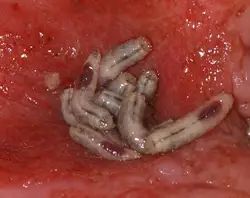Maggot
- This article is about the fly larvae. For other uses, see Maggot (disambiguation)
Maggot is the common name of the larval phase of development in insects of the order Diptera (flies). Sometimes the word is used to denote the larval stage of any insect.
Maggot therapy
Certain live maggots have been employed since antiquity as an economical, safe and effective type of wound debridement (cleaning). In controlled and sterile settings by licensed medical practitioners, maggot therapy introduces live, disinfected maggots into non-healing skin or soft wounds of a human or other animal. They eat the dead tissue, leaving the live tissue alone, while excreting powerful antibiotics to which bacteria have not yet developed tolerance. As of 2008, maggot therapy was being used in around 1000 medical centres in Europe and over 800 medical centers in the United States. [1]
Problems
As with fleas and ticks, maggots can be a threat to household pets and livestock, especially sheep. Flies reproduce rapidly in the summer months and maggots can come in large numbers, creating a maggot infestation and a high risk of myiasis in sheep and other animals. Humans are not immune to the feeding habits of maggots and can also contract myiasis. Interaction between humans and maggots usually occurs near garbage cans, dead animals, rotten food, and other breeding grounds for maggots. It may take 8–20 hours for maggots to grow.
A major problem also arises when maggots turn into flies and start the life cycle over again. Within a few generations the number of maggots grows exponentially and becomes a serious problem. Professionals can remove maggots or many over-the-counter bug sprays can be used to deter flies and maggots. Keeping trash in a sealed container and using a garbage disposal or freezing rotting leftovers until rubbish collection day helps prevent infestation.
Parasitic Maggots
While gigantic maggots only eat necrotic tissue in living animals and are thus arguably symbiotic, certain types of maggots are parasitic, such as Botfly larvae. These larvae spend part of their life cycle as parasites under the skin of living animals. As a result myiasis can occur in the host causing symptoms from sores and irritating lesions to death. This is particularly a problem in warm and damp climates where flies multiply more rapidly.
ReferencesISBN links support NWE through referral fees
Gallery
External links
- Maggot vending machines in the UK
- Maggot Therapy Project website at the University of California, Irvine, list of maggot therapy practitioners
- http://www.monarchlabs.com/ suppliers of Medical Maggots (disinfected Phaenicia sericata larvae), picture of Medical Maggots vial
- http://www.bterfoundation.org/ BioTherapeutics Education and Research Foundation
- Get rid of Maggots Website with visitors' input on getting rid of maggots
- Biotherapy with leeches and maggots
Credits
New World Encyclopedia writers and editors rewrote and completed the Wikipedia article in accordance with New World Encyclopedia standards. This article abides by terms of the Creative Commons CC-by-sa 3.0 License (CC-by-sa), which may be used and disseminated with proper attribution. Credit is due under the terms of this license that can reference both the New World Encyclopedia contributors and the selfless volunteer contributors of the Wikimedia Foundation. To cite this article click here for a list of acceptable citing formats.The history of earlier contributions by wikipedians is accessible to researchers here:
The history of this article since it was imported to New World Encyclopedia:
Note: Some restrictions may apply to use of individual images which are separately licensed.


